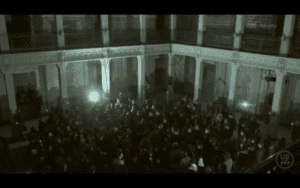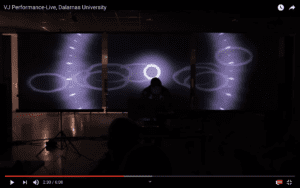Live Cinema and VJing can be said to be two branches of live audiovisual performance. Through the reading, I can tell that a group of artists have discrimination against VJing – they are trying to build hierarchy under the category of live audiovisual performance. The group of artists is represented by Amy Alexander, Toby Harris, and Makela. According to Live Cinema by Gabriel Menotti and Live Audiovisual Performance by Ana Carvalho, Toby Harris, he articulates how the monotony of everyday VJing presentations – “stuck in nightclubs and treated as wallpaper” (89). In contrast, live cinema is an art that “invites the audience to construct narrative and cultural critique” (89). What’s more, the connection between live cinema and narrative is verbalized in a statement by Chris Allen, a member of The Light Surgeons, who describe their work as a “deconstructed, exploded kind of filmmaking that involves narrative and storytelling” (91). In addition to Toby Harris’s different description of two forms of live art, Makela adds a primary and secondary relationship between these two. When we have A closer reading of Makela, she indeed asserts that cinema now includes “all forms of configuring moving images”. Nevertheless, she insists that live cinema is “in essence artistic”, and therefore can be set apart from VJing. More explicitly, Markela even remarks that “many Live Cinema creators feel the need to separate themselves from the VJ scene altogether, in order to establish their own artistic goals, which would rarely find an appreciative audience in a club environment (93). She is not only suggesting a sort of hierarchy of values in the realm of audiovisual performance but also imposing discrimination on VJing. Another difference between VJing and live cinema is the position of the player. Performing live cinema means not falling into contingent collaborations with any DJ, lighting engineer, or set producer that might be on that day’s shift, as a VJ often has to do. In live cinema, the performer directs every aspect of the spectacle, never being relegated to a secondary role (95). Along with the dominant right, Live cinema also masters other influences. To call a performance “live cinema” is more than invoking a background. It is to inscribe this performance in a tradition, supposedly dissolving any suspicion that might exist about its cultural relevance. Not only implying a cultural background, but live cinema also upholds a particular cultural meaning and relevance, the concept of live cinema can be useful not only for audiovisual performance but also for cinema itself (99). The term of live cinema’s distinction from other media actually becomes enforced, allowing it to keep a certain prominence instead of challenging cinema’s specificities (101).
The definition and meaning of the term of live audiovisual performance seem to be much more general. Both live cinema and VJing are categories under live audiovisual performance. However, it is general but complex. Live audiovisual performance is complex because it does not comprise a specific style, technique, or medium, but instead gathers a series of common elements that simultaneously identify a group of artistic expressions as well as specific works, which don’t necessarily fit within either of the particular expressions that constitute the group (131). Amy Alexander differentiates between VJing and live cinema but does not address live audiovisual performance as a practice with its own particular features (135). I have found some videos from the internet, the first one is Otolab’s Punto Zero.

Setting the audience inside the range of the project, the project has strong engagements with the audience, which is an explicit characteristic of live cinema. In contrast, a VJ performance from Dalanars University

seems more static – it is not saying the image is static, but it has no interactions between the audience and the project itself. It is more like the interaction between the player and the computer. As Kinetic Lights – Atom
has shown, live performance (not considering VJing) often includes a physical part, a feeling of telling a story, and indicates a certain background. What’s more, Guy Sherwin’s ‘Man with Mirror’
indicates that “a thorough interpretation of live cinema would mean taking these and other elements that collaborate in the continuing production of moving images more seriously into account” (103). Combining these with the previous critics on Vjing, actually, it would be more appropriate to construct flexible structures connecting the different works rather than using a rigid series of definitions (141). The better future development of live audiovisual performance should always “pointing ahead to the next turn that will be provoked technologically, politically, aesthetically, or by affections between the elements of the community” (143).